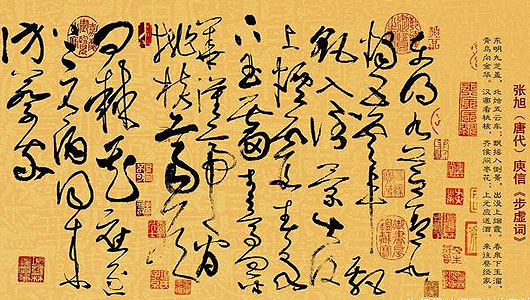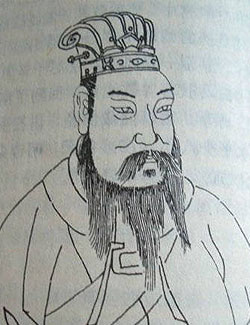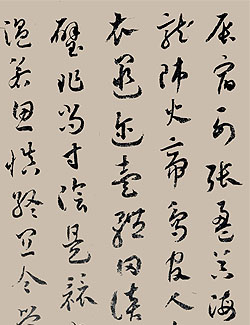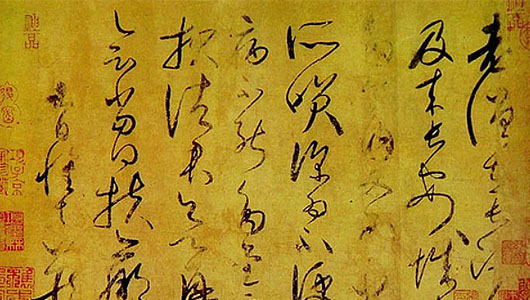Cao Shu (草书), a "kurzív" vagy a "fű-írás"
Cao shu (草书) also known as grass style, running script or cursive script) is the most simplified but abstract and difficult form of writing in Chinese calligraphy. Among all Chinese calligraphy styles, cao shu usually demands the highest levels of techniques while expressing the maximum freedom (in conformity with many complex rules.)
Cao shu was developed almost at the same time with li shu (隸书). Since the Han Dynasty, li shu and cao shu were developed and established. From the Han Dynasty to the Qin and Tang Dynasties, there were many famous cao style calligraphers. Cao shu reached one of its peaks during the Qin Dynasty when Wang Xizhi (王羲之, 303-361) and his son, Wang Xuanzhi (王獻之, 344-386), were both good at this style. The father and son are referred as "the Two Wangs" (二王) in the Chinese calligraphy history. They influenced later calligraphers in each dynasty, especially for Hsin and cao styles. Later in the Tang Dynasty, two great calligraphers, Zhang Xu (張旭, 675-750) and Huai Su (懷素, 725-785), were both reaching another peak in cao shu.

張旭(675年—約750年),字伯高,一字季明,漢族,唐朝吳縣(今江蘇蘇州)人,開元、天寶時在世,曾任常熟縣尉,金吾長史
Cao is generally considered the most difficult style among all five major Chinese calligraphy styles. Calligraphers specializing in cao style decreased in number since the Tang Dynasty.
Features of Cao Shu
The main feature of cao shu is to simplify the left sidepiece (radical) of a character and focus on the right sidepiece - "Yi Zuo Yang You 抑左揚右" literally simplify the left and focus on the right. Thus a calligraphy work in cao style will look more smooth, connecting and faster with abrupt turning and dramatic effects.
The following is a chart that lists each character in kais stye and three ways of writing that character in cao style. Like zhuan style, a character can be written in many ways in cao style. From the above examples, we may know that "simplifying the left and focusing on the right" is a major rule for creating a cao style character by different ancient calligraphers. The calligraphers obey the prototype more strictly on the left side while they have leeway for artistic design on the right side. If a laymen tries to coin his way of creating a cao style character without learning and basis, he may end up making mistakes. Adding or removing a single dot in one position can turn a Cao character into another one. For example, "Wei #2" and "Zu #3" are just different in one dot. There are innumerous close differences or similarities like this since the total number of Chinese characters is so large.
If art does not impose some norms or standards, everybody can do it in his own way without learning and practicing. Consequently, people won’t appreciate or recognize each other’s efforts and contribution. Just as languages and music have their own grammars, Chinese calligraphy has sets of strict rules, especially for cao and zuan styles.
Revolution & Changes of Cao Shu
During the Emperor Zhang’s (漢章帝) reign in the Han Dynasty, calligrapher Du Du (杜度 ?-?) was allowed to present documents in cao style to the emperor. Thus his cao style was called "zhang cao 章草".


The zhang cao style (章草)
After Du Du, there were Cui Yuan (崔瑗, 77–142), Cui Shu, Zhang Zhi, and Zhang Zun. Among them, Zhang Zhi (張芝, ?-192) was the first calligrapher to earn the title "King of Caoshu 草聖" and he taught many students. He was the founder of the modern school of cao shu ("Jin Cao 今草", "Jin" means today or modern.) He had a great influence on Wang Xizhi and especially Wang Xuanzhi. During this era, there were many schools of cao shu and this became very, very popular in all walks of life and had a great impact on the whole nation and society.
During the late Han Dynasty and the Wei and Qin Dynasties, almost every scholar could write cao shu. The royal members of the Qin Dynasties were even writing letters in cao shu and exchanged their insights and skills. Those royal calligraphers included Wang Xizhi (王羲之, 303-361), Yu Yi (庾翼, 305-345), Wang Xuanzhi (王獻之, 344-386), Xie An (謝安, 320-385), and so on. Thus, cao shu took a quantum leap in the Qin Dynasty.
Resurrection of cao shu
In the Tang Dynasty, both Zhang Xu (張旭, 675-750) and Huai Su (懷素, 725-785, courtesy name Zangzhen (藏真) liked to write calligraphy after getting drunk. They would yell, stride, and show weird behaviors during their creation. They were peered as "Crazy Zhang & Weird Monk 張顛狂僧". They established a cao style commonly referred as Wild Cursive "kuang cao 狂草" where the "kuang" means crazy and bold.

Huai Su (懷素, 725-785) work - the kuang cao 狂草 style
From the Han Dynasty to the Tang Dynasty, cao shu had three major changes in styles and structures. The way a character was written in cao shu was already established in the Han Dynasty; the following changes in the Jin and Tang Dynasties were only for the strokes and character structures for the sake of art. So there are three main styles of cao Shu:
- Zhang cao (章草),
- Jin cao (今草), and
- Kuang Cao (狂草).
In early 1900s, Yu Youren (于右任, 1879-1964) promoted standardized cao shu due to the drastic irregularities and differences between each cao shu calligrapher and character in different dynasties. He founded the "Society of Standardization of cao shu". He studied ancient calligraphy works in cao shu and revitalized and promoted cao shu to the modern society based on the four principles - "easy to read, easy to write, accurate, and beautiful".
Guide to Start cao shu
Among the five major styles of Chinese calligraphy, cao style is probably the most difficult due to technical requirements and foundation. Only after one has mastered kai and xing shu can he or she begin to learn cao style. A lot of calligraphy teachers prefer students to start from jin cao (今草). A proper sequence of learning is very important to build a good foundation.
Since the sidepiece or radical (Bu So 部首), derivatives, alternatives, borrowing, mixture, and various rules can be very confusing, a student may resort to cao shu manuals or dictionaries to better understand the writing principles and avoid errors. A beginner may choose to start from "The 1000 Characters in Cao Shu 草書千字文" by Zhi Yong (智永), Huai Su (懷素) or other calligraphers.
After the student has mastered the rules, requirements, structures, stroke sequences, and connections between several characters, s/he may proceed to kuang cao or zhang cao from jin cao.
Please also remember the Center Tip Theory "zhong feng 中鋒理論" (literally, brush pen tip at the middle of hairs) is very important for jin cao and kuang cao writing. It was mentioned by every prominent calligrapher. When Yan Zhenqing stated how his teacher Zhang Xu passed to him the secrets of using a brush, he pointed out that a calligraphy stroke should look like drawing on sand with awl "Zhui Hua Sa 錐劃沙" The principle requires keeping our brush handles and brush hair as straight and vertical as possible. It’s different from painting or the Western way to hold a pen. According to this principle, we should never ever bend the brush handle and the hair. We may rotate the brush when necessary with fingertips (knuckles not recommended). Bending a brush outward, sideways or toward oneself is a very common defect and is seen among laymen. By strictly obeying this principle, the hairs (or the sharpness of hairs) of a brush are hiding inside during brush motions rather than going scattered and collapsed.
Masters & works of cao shu
Du Du (杜度, ?-?) [baidu]
He was allowed to present reports to the Emperor Zhang (漢章帝) in running style calligraphy. Thus his cao style was called "zhang cao 章草". Even the King of Cao Style, Zhang Zhi, admitted that his work was inferior to Du Du’s and Cui Yuan’s (崔瑗, 77-142) works.
Cui Yuan (崔瑗, 77-142) [wikipedia]
He was good at zhang cao. His book "Cao Shu Postures 草書勢" was valued by later calligraphy theorists. His cao shu was not as ingenious in structures as his teacher Du Du but was more charming than Du Du's. He was peered with Du Du. His style was masculine and vigorous.
Zhang Zhi (張芝, ?-193) [wikipedia]
He won the title "King of Cao Shu 草聖". He practiced calligraphy by a pond and it became black because he washed his brushes and ink plate there. He studied zhang cao from Du Du and Cui Yuan and then established the modern style of cao shu. He had a great influence on Wang Xizhi and Wang Xuanzhi.
Wang Xuanzhi (王獻之, 344-386) [wikipedia]
The 7th son of Wang Xizhi. He studied his father's calligraphy earlier and studied Zhang Zhi's calligraphy later. He reformed bravely. His style was brilliant and heroic.
Sun Guoting (孫過庭, 648—703) [wikipedia]
Famous cao shu calligrapher and theorist in the Tang Dynasty. He inherited the Two Wangs’ method. His work shown here (書譜) is an important essay about cao shu.
Zhang Xu (張旭, 675-750) [wikipedia]
He also won the title "King of Cao Shu 草聖" after Zhang Zhi. Every time he was drunk, he was inspired and did a terrific work. He was nicknamed "Crazy Zhang". Zhang Xu's calligraphy, Li Bai's poem, and Pei Ming's sword playing were the "three exquisite talents in the Tang Dynasty". Zhang Xu was a nephew of Lu Jianzhi’s son. Lu Jianzhi (陸柬之, 585-638) was a nephew of Yu Shinan (虞世南, 558-638). From the family lineage, Zhang Xu inherited the secrets and system from Cui Yuan, Zhong Yao, Wang Xizhi, Wang Xuanzhi, and Yu Shinan; however, he represented calligraphy strokes in a brand-new look and invention. His followers included Xu Hao, Yan Zhenqing, and Cui Miao.
Huai Su (懷素, 725-785) [wikipedia]
He became a monk at ten years old. He was very fond of wine, just like Zhang Xu. He would write beautifully and quickly whilst he became drunk and inspired. His calligraphy was like a running snake or a flying dragon and also resembled strong wind, violent storm and thundering. His cao shu was peered with Zhang Xu’s. He called his writing "The calligraphy of an intoxicated immortal". He was highly regarded by Yan Zhenqing, Lu Xian and Zhang Wei. Being very poor, and lacking money to buy paper, he planted many banana trees in his backyard and used the leaves for practice. It is said that he practiced so hard that he had piles of bad brushes like a tomb and most of his banana leaves were black.
Xian Yushu (鮮于樞, 1246-1302) [wikipedia]
He studied Zhang Tiensi’s work first, then Qin & Tang Dynasties’ calligraphy to establish his style. Inherited the Two Wangs’ spirit.
Summary of Learning
Most Chinese calligraphers agree that a beginner in cao style starts learning jin cao before kuang cao and zhang cao. Each of them has unique underlying principles to write a character. However, kuang cao is more metaphysical and abstract and looks crazy. It sometimes does not follow strictly the rules and principles as set by jin cao. However, this does not mean one can create his own way of writing a cao shu character randomly without following any rules. If so, there will not be any standard to appreciate each other's work and achievement. We may learn more broadly and deeply by collecting and appreciating ancient masterpieces. From analyzing each masterpiece and master, we may eventually realize their learning sources, creation processes and why their immortal works have remained famous for thousands of years. Learn and we will know our insufficiency; study abroad then we may specialize.
Glossary
- Center Tip Theory (中鋒理論) – Holding a brush vertically but not bent; never let hairs collapse.
- Jin cao (今草) – Founded by Zhang Zhi in the Han Dynasty.
- Kuang cao (狂草) – Founded by Zhang Xu in the Tang Dynasty.
- Yi Zuo Yang Yu (抑左揚右) – Simplify left sidepiece and focus on right sidepiece in a cao shu character.
- Zhang cao (章草) – Founded by Du Du in the Han Dynasty.

